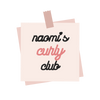Repairing Heat, Colour or Chemically Damaged Hair

If you have curly or natural hair, you know that taking care of it can be a bit more challenging than other hair types. Growing up, we face an almost constant scourge of negative and hurtful behaviour and comments targeted towards our hair, and this can leave us pressured to alter our hair's state. The over usage of chemical, heat or colour styling can leave the cuticle in pretty bad shape, but don't worry - with a little extra care, time, patience, support and attention, you can repair your hair and restore the beautiful and natural state of your hair.
The key to repairing damaged hair is to be gentle and consistent with your treatment. Over-manipulating and continuing to use harmful appliances and practices can further damage your hair and make it more difficult to repair. Remember, there's no get-fixed-quick schemes involved in this. Instead, focus on using water, deep conditioning treatments, and protein treatments to help rebuild your hair's strength and resilience.
Using Protein Treatments to Repair Your Hair
Protein is a key component of hair, and when hair is damaged, it means that the protein bonds in your hair have been weakened or broken. This can happen due to physical damage (like heat styling or over-manipulation) or chemical damage (from hair dye or bleach). Protein treatments work by replenishing the proteins in your hair that the body uses to rebuild the damaged or broken cuticle. Utilize protein treatments like the Olaplex No.3 Hair Perfector or the Aphogee Two-Step Protein Treatment once or twice a month to help rebuild or maintain your chemical, heat or coloured hair.
Deep Condition Regularly
Another important step in repairing hair damage is to deep condition your hair regularly. This will help to add moisture and hydration back into your hair, as well as locking in nutrients that can help to improve the overall health of your hair. Look for a deep conditioner that contains ingredients like aloe vera, blueberry, shea butter or avocado oil, which all contain strengthening and hydrating properties that will help rebuild the hair. We recommend deep conditioning every time you wash, and leaving your deep conditioner on for 10 to 15 minutes each time. Try some of our best-selling deep conditioners like the tgin Honey Miracle Masque, the Mielle Organics Rosemary and Mint Strengthening Masque or the Camille Rose Algae Renew Deep Conditioning Mask.
Avoid Heat and Over-Manipulation
One of the best ways to prevent hair damage is to avoid heat styling and over-manipulating your hair. If you do use heat appliances, be sure to use a heat protectant spray or cream beforehand, like the Mielle Organics Mongongo Thermal Heat Protectant Spray or the tgin Green Tea Super Moist Leave In Conditioner. When detangling your hair, ensure to use a slippery detangler like the Aunt Jackie's Knot On My Watch Detangling Therapy and high quality detangling brush like the D3 Denman Styling Brush to ensure that you are keeping the strand intact.
Trim The Irreparable Hair Strands
If you find that your hair is severely damaged and no amount of treatments seem to be helping, then it may be time for a trim. This will help to get rid of any hair strands that are so damaged that they cannot be repaired, which will ultimately make your hair appear healthier overall. While it may be difficult to cut off some of your length, remember that your hair will always grow back, and it'll be much healthier and easier to maintain.
Be Consistent with Your Treatment
Repairing hair damage takes time, but consistency is key to seeing results. By following the tips above and being consistent with your treatment, you will begin to see your hair become stronger and more resilient over time. Have patience, focus on being gentle with your hair, and enjoy the journey of restoring your hair back to its beautifully natural state.







